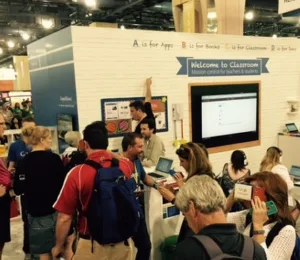Immersive virtual reality has never had a significant footprint at ed-tech conferences—until now. The ISTE 2015 educational conference, with over 21,000 in attendance, is the largest ed-tech conference held in the U.S. Yet the real story underlying this conference begins and ends with some starkly visible trends. One of these trends this year was the robust arrival of 3D Virtual Reality, which I like to call Immersive 3D, because “the fourth wall” of the camera lens is removed, and the viewer is placed in the middle of the action, surrounded on all sides by the learning environment.

The strong presence of immersive virtual reality solutions on the exhibit hall floor at ISTE 2015 surprised me. Why? Because I usually see more virtual reality playgrounds at InfoComm than I see at the annual ISTE conferences. The whole situation was reversed this year. At InfoComm 2015 I found zero virtual reality demonstrations on the exhibit hall floor. I did run into Craig Sinard of VR-MAX, who was traversing the InfoComm expo, however. (VR-MAX produces interactive stereoscopic on-demand 3D content for domes, caves, or any interactive surface, but always starts from the perspective of immersive VR as their first love.) But virtual reality was conspicuously absent everywhere else at InfoComm.
AT ISTE 2015, however, 3D virtual reality drew swarming crowds in the exhibit hall, perhaps presaging the buzz we heard about VR at the recent SIGGRAPH gathering in other Display Daily reporting. Here’s the rub on immersive VR at ISTE 2015:
Samsung’s Classroom of the Future
The first technology ‘swarm’ I encountered upon first entering the ISTE exhibit hall took place at the impressive Samsung booth. Featuring a vision of the “classroom of the future”, Samsung was demonstrating the latest version of its Samsung Gear VR headset. The kicker was their under-the-ocean, high-quality content. The whales, the dolphins, the sun glimmering through the watery ceiling above, the teeming ocean life—all created an experience that absolutely delighted throngs of educators. I have not seen so many “oohs and ahhs” coming from educators since the early days of 3D in education, when TI first introduced educators to 3D projectors. I’m pretty picky about 3D content, and still, I was impressed. The quality of the imagery, the comfort, the slow savoring approach to stereo 3D visualization was quite refreshing and captivating. It should be noted that nowhere was the term 3D mentioned, although this experience is truly and richly stereoscopic. See my reasons why the 3D nomenclature is rapidly disappearing from our lexicon.
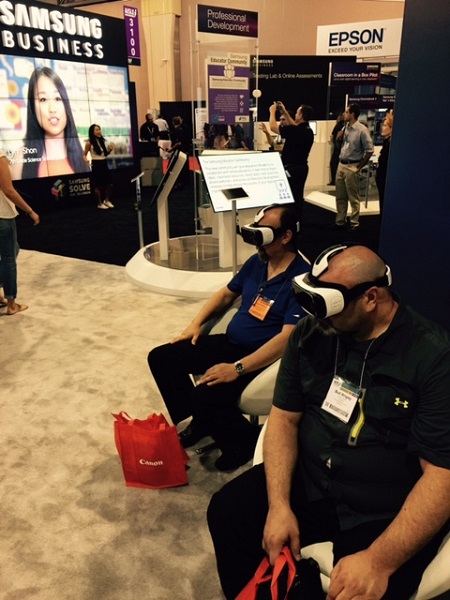 Samsung showing Gear VR at the ISTE 2015 Conference
Samsung showing Gear VR at the ISTE 2015 Conference
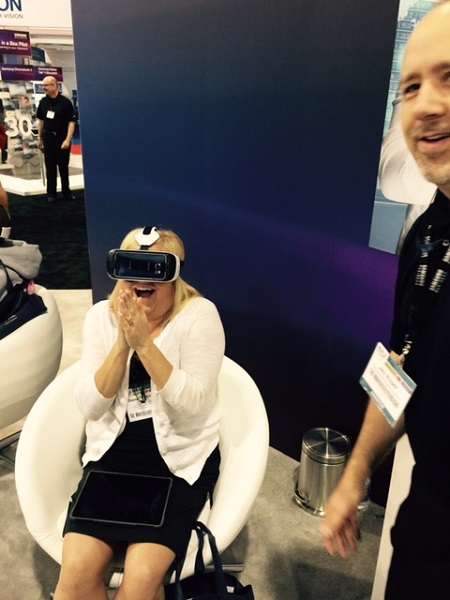 Gasps of delight coming from Samsung’s Gear VR experience at ISTE 2015
Gasps of delight coming from Samsung’s Gear VR experience at ISTE 2015
Google’s Cardboard VR
Flocks of teachers stood in line throughout the conference to see Google’s new Cardboard virtual experience. The lines were long each time I passed them. The oohs, ahhs, and excitement not only rivalled, but exceeded what I observed at the Samsung booth. But, hey!—it’s Google. Interestingly, Google has apparently assembled a Who’s Who of content partners, shown in the graphic below in creating its slate of immersive virtual experiences, called expeditions:
Again, it should be noted that nowhere was the term 3D mentioned, although this Google Cardboard experience is truly and richly stereoscopic. Again, see my reasons why.
The endless Google Cardboard viewing queue
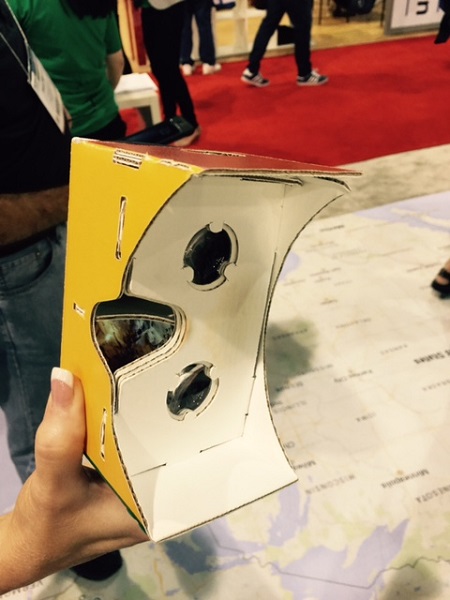 Google Cardboard is made of–well–cardboard.
Google Cardboard is made of–well–cardboard.
Hi-Fidelity
Hi-Fidelity also saw some nice traffic while featuring its immersive virtual reality teaching environment. This Oculus-focused environment allows educators to securely host their own virtual classroom environment, create 3D virtual reality content, or buy 3D content from other educators. They were even offering educators sizeable grants to help develop course content—a real carrot. In their booth, Hi-Fi was demonstrating their hosted Cell Science 3D virtual simulation (content produced by Dynamoidapps). You can see it yourself by signing up for an account here, and accessing this download to the user interface. This simulation allows a class of students and their teachers to shrink themselves and enter a virtual world; to catch a ride on proteins, to explore molecular processes, or to walk inside a ribosome or hexokinase and map its characteristics. The content is in immersive stereo 3D. The Hi-Fi platform enables the teachers and the students to communicate to each other within the virtual environment. (Teachers can use the communications features to conduct tours, give assignments, provide explanations, or otherwise ask questions and assess student learning.) And of course, as I reviewed their promotional literature, there is little mention of the term 3D. (Just once!)
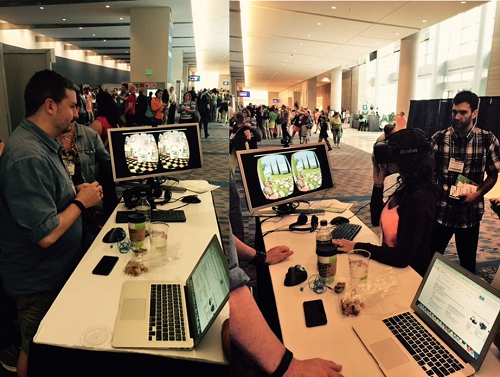 A VR poster session at ISTE 2015
A VR poster session at ISTE 2015
In the Conference
At the ISTE conference, there were three educational sessions touching on immersive VR. Two were my sessions. A third, focusing on a project using Oculus Rift in the classroom, was led by a team of K-12 high school educators. But the strongest presence emerged from a strong endorsement of immersive VR by the opening keynote speaker, former CNN host and journalist Soledad O’Brien. She showed a clip of the Google Cardboard phenomenon, which created curiosity or cemented the theme in the minds of many attendees with whom I spoke.
Is there a bright future ahead for immersive VR in education? Many think so. Not wanting to commit regicide, given the recent public coronation of immersive VR in the press, it’s also possible that the emperor may have no clothes. In a future article, I will uncover some of the potential nemeses of the burgeoning movement toward immersive VR in education. Stay tuned… –Len Scrogan

